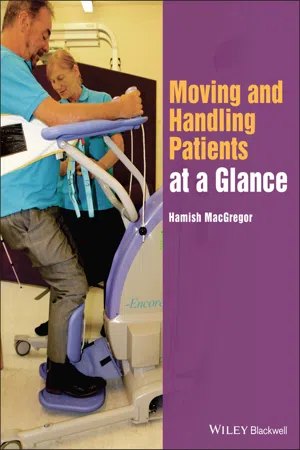
Moving and Handling Patients at a Glance
Hamish MacGregor
- English
- ePUB (mobile friendly)
- Available on iOS & Android
Moving and Handling Patients at a Glance
Hamish MacGregor
About This Book
Moving and Handling Patients at a Glance
The market-leading at a Glance series is popular among healthcare students and newly qualified practitioners for its concise and simple approach and excellent illustrations.
Each bite-sized chapter is covered in a double-page spread with clear, easy-to-follow diagrams, supported by succinct explanatory text. Covering a wide range of topics, books in the at a Glance series are ideal as introductory texts for teaching, learning and revision, and are useful throughout university and beyond.
Everything you need to know about Moving and Handling Patients … at a Glance!
From the publishers of the market-leading at a Glance series comes a succinct and visual guide to the topic of moving and handling. Wide-ranging yet easy to read, Moving and Handling Patients at a Glance provides an accessible introduction to the key theoretical underpinnings of moving and handling, including the legal aspects, biomechanics, risk assessment and safe principles of handling. It then explores the practical aspects of handling, supported by clear and straightforward illustrations and photographs.
- A clear, concise and comprehensive guide to moving and handling patients
- Superbly illustrated, with full colour photographs throughout
- Practice-oriented and based on the latest evidence to provide safe and effective patient care
- Available in a wide-range of digital formats — perfect for on-the-go study and revision
Moving and Handling Patients at a Glance is ideal for nursing students, health care assistants, newly qualified nurses, as well as physiotherapists and occupational therapists.
For more information on the complete range of Wiley nursing publishing, please visit: www.wileynursing.com
To receive automatic updates on Wiley books and journals, join our email list. Sign up today at www.wiley.com/email
All content reviewed by students for students
Wiley Health Science books are designed exactly for their intended audience. All of our books are developed in collaboration with students. This means that our books are always published with you, the student, in mind
If you would like to be one of our student reviewers, go to www.reviewnursingbooks.com to find out more.
This new edition is also available as an e-book.
For more details, please see www.wiley.com/buy/9781118853436 or scan this QR code:
Moving and Handling Patirnts at a Glance is also available as a digital tetbook. For more details, visit http://bit.ly/MHp1AG
Frequently asked questions
Information
Part 1
Theory
- 1 Legislation
- 2 Legislation
- 3 Structure and function of the spine
- 4 Posture and back care
- 5 Safe principles of moving and handling
- 6 Controversial techniques
- 7 Risk assessment: moving and handling
- 8 Risk assessment: general
- 9 Individual patient handling assessment
1
Legislation: I

The Health and Safety at Work Act 1974 (HSWA)
The Management of Health and Safety at Work Regulations 1999 (MHSWR)
- The likelihood of the hazard or the risk concerned occurring.
- The degree of harm that might result from the hazard or the risk.
- What the person concerned knows, or ought reasonably to know, about the hazard or risk, and ways of eliminating or minimising the risk.
- The availability and suitability of ways to eliminate or minimise the risk.
- Assessing if the cost of eliminating or reducing the risk is grossly disproportionate to the actual risk.
Manual Handling Operations Regulations 1992 as amended 2002 (MHOR)
- Any transporting or supporting of a load (including the lifting, putting down, pushing, pulling, carrying or moving thereof) by hand or bodily force.
Table of contents
- Cover
- Front Matter
- Title page
- Copyright
- Preface
- Acknowledgments
- Part 1 Theory
- Part 2 Practice
- Case study 1: Assessing a bariatric patient
- Case study 2: Managing leg ulcer dressings in the community (kneeling)
- Index
- EULA